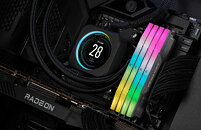- Joined
- Oct 9, 2007
- Messages
- 47,752 (7.42/day)
- Location
- Dublin, Ireland
| System Name | RBMK-1000 |
|---|---|
| Processor | AMD Ryzen 7 5700G |
| Motherboard | Gigabyte B550 AORUS Elite V2 |
| Cooling | DeepCool Gammax L240 V2 |
| Memory | 2x 16GB DDR4-3200 |
| Video Card(s) | Galax RTX 4070 Ti EX |
| Storage | Samsung 990 1TB |
| Display(s) | BenQ 1440p 60 Hz 27-inch |
| Case | Corsair Carbide 100R |
| Audio Device(s) | ASUS SupremeFX S1220A |
| Power Supply | Cooler Master MWE Gold 650W |
| Mouse | ASUS ROG Strix Impact |
| Keyboard | Gamdias Hermes E2 |
| Software | Windows 11 Pro |
AMD's upcoming Ryzen 9000 series "Granite Ridge" desktop processors based on the "Zen 5" microarchitecture will see a slight improvement in memory overclocking capabilities. A chiplet-based processor, just like the Ryzen 7000 "Raphael," "Granite Ridge" combines one or two "Zen 5" CCDs, each built on the TSMC 4 nm process, with a client I/O die (cIOD) built on the 6 nm node. The cIOD of "Granite Ridge" appears to be almost identical to that of "Raphael." This is the chiplet that contains the processor's DDR5 memory controllers.
As part of the update, Ryzen 9000 "Granite Ridge" should be able to run DDR5-6400 with a 1:1 ratio between the MCLK and FCLK domains. This is a slight increase from the DDR5-6000 sweetspot speed of Ryzen 7000 "Raphael" processors. AMD is reportedly making it possible for motherboard manufacturers and prebuilt OEMs to enable a 1:2 ratio, making it possible to run high memory speeds such as DDR5-8000, although performance returns with memory speeds would begin to diminish beyond the DDR5-6400 @ 1:1 setting. Memory manufacturers should launch a new wave of DDR5 memory kits with AMD EXPO profiles for DDR5-6400.

View at TechPowerUp Main Site | Source
As part of the update, Ryzen 9000 "Granite Ridge" should be able to run DDR5-6400 with a 1:1 ratio between the MCLK and FCLK domains. This is a slight increase from the DDR5-6000 sweetspot speed of Ryzen 7000 "Raphael" processors. AMD is reportedly making it possible for motherboard manufacturers and prebuilt OEMs to enable a 1:2 ratio, making it possible to run high memory speeds such as DDR5-8000, although performance returns with memory speeds would begin to diminish beyond the DDR5-6400 @ 1:1 setting. Memory manufacturers should launch a new wave of DDR5 memory kits with AMD EXPO profiles for DDR5-6400.

View at TechPowerUp Main Site | Source






